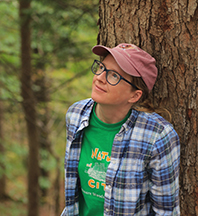Week of December 29, 2024 – January 4, 2025

by Anna Stunkel, Environmental Educator
These days, the weather can be rainy and in the forties one minute and freezing cold and snowy the next! Constant snow cover isn’t a near guarantee the way it used to be in the winter, but we can still search for other critter signs when tracks are difficult to spot.
Our Nature’s Little Explorers group of preschoolers recently had a lot of fun searching for critter signs. As we set off down the trail, we began noticing scat in many places. Kids are usually very intrigued to learn that scat is just a sciencey name for animal poop! There was a lot of Raccoon scat in different spots. These animals had clearly been snacking on berries, evident from all of the seeds in their scat. Further down the trail, we found probable Coyote scat as well. You can tell different types of scat apart by the shape and the contents; is it mostly made of fur, or berry seeds for example? Herbivores like deer often poop in pellet form, while carnivores have tapered scat with fur in it.
Chewed walnuts and other kinds of nuts are another sign that you can search for when tracks are faint. Can you spot piles where these foods are being cached for later? You might even notice tunnel networks through the ground, or through the snow if it’s present. These are signs of small mammals like voles, moles, shrews, and mice.
When searching for animal signs, Beaver chews can be among the most obvious and intriguing. The nature’s little explorers group discovered a total of ten trees that were once chewed down by Beavers back when there were beaver dams near the Harrison Trail. Beaver chews are often recognized by their distinctive triangular shape where the trees were felled, but sometimes they chew in unusual patterns. One time, I was amazed to find a log that was carefully chewed at equal intervals. I couldn’t figure out exactly why a Beaver would do this, but perhaps they were planning to carry away the log segments one by one. Beavers feed on the inner part of tree bark, called the cambium, and sometimes you can also find entire logs or branches chewed bare.
The more you look around, the more signs like these might reveal themselves. Even if we don’t see the critters that left signs behind, these stories can tell us a lot about where animals are going and what they’re eating. Whether there is snow on the ground or not, try going on a search for animal signs to see how many you can spot!

